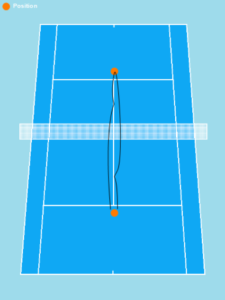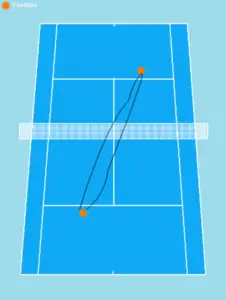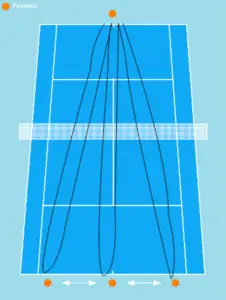Tennis backhand exercises
The best 7 tennis backhand exercises for beginners
The best 7 tennis backhand exercises for beginners
The backhand is considered a weakness by many tennis beginners. This doesn’t have to be the case – with the right backhand exercises you can stabilize it and develop it into a secret weapon. It is important that the backhand exercises are applied with the correct backhand technique to achieve long-term success.
After the completed warm-up program, below we explain to tennis beginners the best 7 backhand exercises for beginners. The backhand exercises can be done with a tennis coach as well as without a tennis coach with another tennis player.
We recommend that you start by doing the backhand exercises in the suggested order. With each repetition your confidence will increase and at the next training session you can start with exercise 3, for example.
If you feel a bit insecure, you should go back one exercise. All in all, the exercises can be used flexibly – have fun with your backhand tennis training.
1. Backhand ball feeling
As on the forehand side, we start by increasing the feel for the ball: to do this, both of you stand on one side of the net and take turns hitting the tennis ball with the backhand, one-handed, vertically upwards at a height of 1-2 meters. The tennis ball should bounce exactly once after each stroke. During the exercise, both of you are constantly in motion.
The goal of the exercise is to play at least 10 flawless vertical backhand strokes – without needing a new tennis ball or having to pick it up again. Repeat the exercise until you feel you can always achieve the 10 error-free backhand strokes under normal circumstances.
2. Topspin technique
To master the backhand topspin technique in tennis, take a tennis racket to the net. There you grip the racket in a two-handed backhand grip and your playing partner clamps the tennis ball between the racket and the edge of the net. In the sideways position, you perform the backhand motion sequence from the point of impact with the overhand grip to the outswing over the shoulder.
Here the tennis ball should fly to the other side of the net and be played with topspin – a clear forward spin – through the overcoat. Your playing partner quickly takes a few steps back after the pinch and catches the tennis balls on the other side of the net, ideally coming up in the T-field. After every three balls, you switch.
3. Backhand from standing
You both position yourselves opposite each other on the T-line and one person gets into the side position for the backhand while the other person puts the tennis racket to the side and throws the tennis ball from below in an arc over the net to the backhand side.
The ball comes flying towards you and bounces once, then you hit the tennis ball back with the two-handed backhand. In the process, the tennis ball should bounce in the T-court and then be caught by your playing partner. After that, the tennis ball is thrown to the backhand side again.
The goal is to play the two-handed backhand topspin – with forward spin – into the opponent’s T-field without making any mistakes. After every 10 strokes you alternate between throwing and hitting.
4. T-field backhand
Again you both position yourselves opposite each other on the T-line, but this time you both have the tennis racket in your hands. After bouncing once, one of you plays the tennis ball over the net on the backhand side with the forehand.
After bouncing, your partner will return the tennis ball with the backhand. Note that after hitting the ball with the forehand, only the backhand is played on both sides of the net. You will be moving around a bit during this exercise, as the ball will not always come flying perfectly to your backhand side.
The goal is to play at least 10 backhand balls back and forth without mistakes – quietly with 2 meters height above the edge of the net. If this is still too difficult at the beginning, there is an intermediate step: instead of hitting the tennis ball directly back, the ball is stopped after bouncing with the tennis racket and presented to itself before it is played back again after bouncing again.

5. Backhand cross
After you have always played longline, it’s time for the backhand cross. Here you face each other diagonally – provided that both play the backhand with the right or left hand.
Again, the goal is to play at least 10 backhand cross balls back and forth without making any mistakes – as before, the tennis ball bounces exactly once in the T-field on each side of the net.

6. Baseline backhand
If you feel confident in the T court by now, you can slowly move across the 3/4 court to the baseline. Please note the correct choice of tennis ball for the corresponding distances.
From the baseline, exercises 3-6 are again a good choice. The difference in exercise 3 is that the ball is no longer thrown to the player, but is hit with the tennis racket over the forehand side and returned with the backhand after the normal bounce.
7. Backhand from the run
After building up a certain stability with the backhand from the standing position, the next level of difficulty is reached: the backhand from the run.
Here, one player distributes the balls after the forehand from the backhand side alternately longline, into the center of the court and cross while the other player returns all balls in the movement with the backhand.
Note that the exercise is also a challenge for the distributing player, as this is the first time he/she will not hit the tennis ball back to where it came from with the backhand but will change direction, which is much more difficult and will lead to mistakes in the beginning.
The goal is again to play at least 10 error-free backhands. If this proves to be too difficult at the beginning, it is advisable to do the exercise in the 3/4 or T court again to gain confidence with the backhand from the run.


